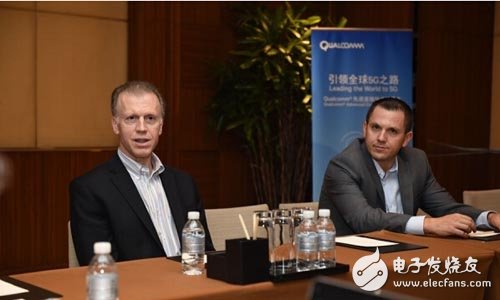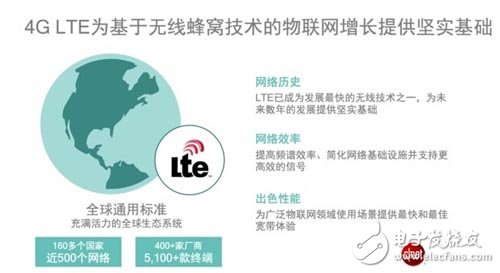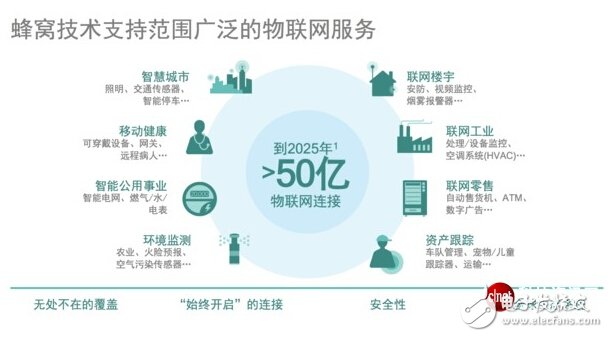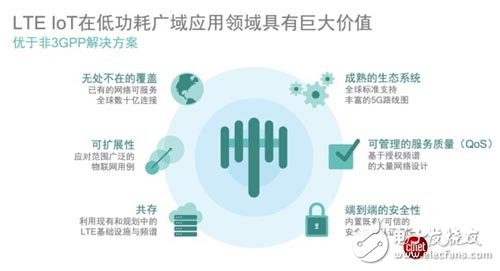Mentioning the definition of the Internet of Things, simply speaking, smart cities, such as lighting, parking, and transportation, can be connected and effectively managed; to mobile health, including patient diagnosis, patient tracking, and various environmental monitoring; Remote tracking of water meters, electricity meters, gas, etc. at home; security and intelligence of buildings, control of industrial automation; and retail business and asset tracking. The Internet of Things is a very broad concept.
“There will be more than 5 billion IoT connections based on cellular technology by 2025.†During this year's MWC Shanghai World Mobile Conference, Qualcomm hosted an advanced connectivity technology communication meeting, Qualcomm product marketing director Shen Lei, all very broad vertical The market needs very strong connection support. There are three basic requirements: the connection must be everywhere, all the time; there must be security guarantees; at the same time, there must be a very complete and fully optimized ecosystem. Looking around, LTE is a best candidate for such connectivity support.
After the meeting, Peter Carson, Senior Director of Marketing at Qualcomm Technologies and Matt Branda, Director of Technical Marketing at Qualcomm Technologies, were interviewed by CNET to explain in detail the relationship between LTE&Wi-Fi and the Internet of Things.

Qualcomm: The connection support for the Internet of Things within 5 years is LTE, we aim at eMTC and NB-IoT
Peter Carson, Senior Director of Marketing, Qualcomm Technologies (left) and Matt Branda, Technical Marketing Director, Qualcomm Technologies, Inc.
In the next 5 years, LTE is the foundation of the development of the Internet of Things
According to GSMA data, as of April 2016, more than 500 operators deployed LTE in more than 160 countries around the world, and more than 400 vendors have released more than 5,000 products supporting LTE. With the boom in smartphones over the past few years, LTE has become the most accessible and most affordable wireless communication mainstream technology.
"LTE and WiFi actually have a clear market segmentation, which is clear division of labor, but gradually merged." Peter Carson believes that the division of labor clearly refers to the technical scenarios, their scope of application is very targeted; and the gradual integration refers to At the user-aware level, we don't need to know whether to use LTE or WiFi, it will automatically choose based on the network coverage of your location.

Nowadays, most Wi-Fi connections in the Internet of Things are based on on-premises, such as companies, homes, schools, shopping malls, etc., and LTE can bring us more wide-area terminal connections. . Since some terminal connections are not short-distance, WiFi power cannot be reached, and the wide-area characteristics of LTE can be connected to terminals that are geographically widely distributed, such as different sensors and remote sensing instruments. When it comes to Enhanced LTE, it has wider coverage and is completely different from Wi-Fi short-distance connections.

Qualcomm currently ships more than 1 billion in IoT terminals, and most of this is based on Wi-Fi or Bluetooth. Peter Carson said that in the next five years, we will see very big development opportunities, Qualcomm will fully explore the untapped market in LTE IoT terminals.
When talking about the problem of narrowband LTE, Shen Lei said that the most important features of narrowband LTE. First, the complexity of the system is greatly reduced, and the complexity and cost are greatly optimized. Second, the power consumption is extremely reduced, and the battery life is greatly enhanced. Third, the coverage of the network has been greatly enhanced. Fourth, the density of network coverage is enhanced. This will support the application of massive IoT deployments.

Of course, if you just translate the existing LTE technology to the IoT terminal, it will not work because, in order to support a wider range of IoT terminal connections, low power consumption and lower data transmission rate are also a requirement. Through 3GPP Release 13, LTE has achieved significant improvements in both network coverage and battery life, but billions of terminals need to be connected to the network.
For the development of LTE, Li Yang, senior manager of Qualcomm product market, reviewed the evolution of the LTE modem from the first generation to today's technology evolution. In 2010, from the first generation of LTE multimode to LTE voice (CSFB), then to VoLTE, carrier aggregation and dual-card LTE, Qualcomm can now support dual downlink carrier aggregation, triple downlink carrier aggregation, dual uplink carrier aggregation, 4x4 MIMO, Four downlink carrier aggregation and download rate of Gigabit LTE. At every point in time, Qualcomm Snapdragon modems are the pace of competitors 2 or 3 generations.
We are offering an extensive series of Hydraulic Pump Spare Parts. These products are extremely employed in the market for diverse purposes. We are offering an extensive series of Hydraulic Pump Spare Parts. These products are extremely employed in the market for diverse purposes.
We are one of the leading wholesaler, trader and service provider of the top-notch quality of Hydraulic Steering Pump, Piston Pumps, Hydraulic Motor, Earthmoving Machine Spare Parts, Hydraulic Piston Pump Repairing Service etc. These products are designed at per the laid industry norms and standards.
Mud Pump Parts,Pump Spare Parts,Mud Pump Overhaul,Diaphragm Pump Spare Parts
Shenyang Zhicheng Heavy Machinery Manufacturing Co., Ltd. , https://www.zhichengmachinery.com